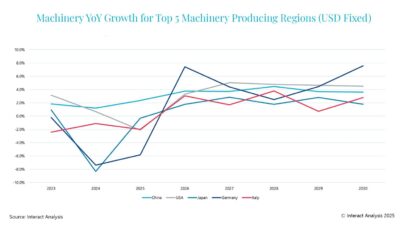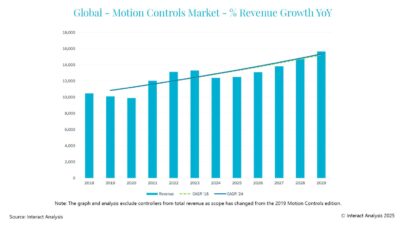Smart system integration and machine control enable a new integrated sortation subsystem to redefine efficiency in high-speed distribution centers.
In a high-volume distribution environment, the speed of package flow through the system as determined by the sortation equipment often determines production speed. It has been a standard for some time that to increase throughput one must increase the speed at which the sortation equipment is running. But, running a sorter faster increases vector stresses on the equipment and on the packages, which means less package control and more maintenance effort. It also decreases the life of the equipment and ultimately increases the equipment cost of ownership.
This scenario changed with the invention of the FlexSort SL Parallel Diverting sorter, which allows increases in throughput to be achieved without increases in system speed. The design of the system benefits from smart machine control.
Avoiding rotation
Typical sortation equipment with angled diverts rotate the boxes to facilitate discharge to the takeaway conveyors. When a package is rotated, essentially it becomes longer because one corner falls back, this means a bigger gap required between packages. FlexSort SL does not need to rotate the boxes, allowing for tighter gaps between the conveyed products. Instead of 6-in. to 12-in. between packages, which is common with sorters using angled diverts, the system requires only 1-in. to 3-in. gaps. The take-away is designed to complete the rotation to the correct orientation, using gravity wheels or powered rollers that rotate and realign the packages.
Because the sorter runs at a slower speed, it can handle packages more positively than contemporary sortation equipment, which runs 20% – 30% faster and creates 35% – 50% higher dynamic loads (the effects on packages when they change direction or speed on the system).
Every distribution system can be divided into five basic functions which it needs to perform including receiving, product storage, picking for order fulfillment, sortation and shipping. Although each of these sectors have experienced improvements due to technical advances, sortation is where significant leaps in efficiency are now being made with Dematic’s introduction of its FlexSort integrated sortation sub-system.
FlexSort is defined by its unique system integration and the efficiencies that the system provides to the high-speed sortation environment. The logic on how the system is controlled is quite different. All sortation functions are controlled as if it is one unified machine. From the pre-merge to the merge, to the transport conveyors feeding the gapping, to the gapping function itself, to the linear sortation and finally the take-away conveyors, the entire process operates with single-source control and full integration.
Automation INSIDE – PLC hardware – Allen Bradley ControlLogix or CompactLogix PLC. The PLC provides overall supervisory control of the sortation system. The PLC is controlling the variable speed of the sorter. It has inputs monitoring the amount of product coming into the system and going off. It controls all the VFDs and the speeds. Allen Bradley was selected because it is the vendor predominantly accepted by its customers in the U.S. |
The FlexSort system is also defined by its system-wide, distributed, variable-speed control, which is uniquely based on how much product is being fed into the system, and how much product is moving out. Unlike any other system, it will automatically adjust its speed incrementally as required.
The system is further defined by the absence of rollers and the extensive use of belts throughout the system. Package control is lost with rollers, and FlexSort demonstrates a maximization of efficient monitoring, routing and control of packages throughout its entire system, unrivaled in contemporary sortation operations.
Finally, FlexSort is defined by its high-speed, parallel-divert sliding shoe sortation, capable of providing a 20 percent increase in efficiency while maintaining comparable throughput volumes.
As a composite system, it brings to high-speed distribution centers a new and unparalleled level of efficiency in product throughput, low operating costs and system availability.
Variable-speed, parallel diverting sortation
When packages tip over or slide on the conveyor and lose their intended position, the potential for side-by-sides, jams and mis-diverts increases, resulting in reduced accuracy, reduced productivity per man-hour due to downtime, and reduced throughput. The overall effectiveness of the system suffers in quality and performance, not due to improper operation, but because of the inherent inefficiencies within the system’s design and application.
A package traveling in a straight line at a constant speed does not experience forces that would cause it to topple or move on the conveyor. But when packages transition from the merge inputs onto the merge (both a directional change and a speed change, from a slow moving input to a fast moving sorter feed), travel around a curve, speed up and slow down for gap adjustments and divert off of the sorter, they experience forces that vary in proportion to the square of their velocity.
A key feature of the FlexSort ISS technology is its ability to automatically vary the system speed with its real-time throughput requirements. The system provides not just a selection of pre-determined speed modes, but rather a gradient spectrum of automated variable speeds.
Because the system runs at a lower average speed, packages will experience significantly lower average forces when they change direction or speed. A system that is designed to handle a high peak rate, for example, but on most days is only utilizing 60 percent of that peak realizes a net speed reduction of 46% with FlexSort ISS versus a fixed-speed system. Force is not linearly proportional to velocity, so in this example the forces on the packages and components of the system are reduced by 70%.
300 cartons per minute
The Dematic FlexSort SL is capable of processing 300 cartons per minute (CPM) at the same speed that contemporary high-speed sorters can process 250 cartons. Conversely, it can process the same number of cartons at 590 feet per minute (FPM) compared to the industry standard of 650 FPM.
A unique feature of the sorter is its use of linear induction motors (LIM) – electro-magnetic drives that move a magnetic field across the face of the drive and move the aluminum slats of the sorter without mechanical contact. An air gap exists between the electromagnet and the slats, which have steel inserts inside. The shoes are also electromechanically directed into divert rails and pushed across the sorter.
Normally on a slat-shoe sorter, all the slats are joined together by a chain that is driven by a sprocket with a conventional drive. The FlexSort SL sorter has no belts, drive chains, gears, sprockets or divert switches. This feature eliminates the need for lubrication.
Most sorters use a mechanical divert switch. This new system uses electromagnetic divert switches that eliminate pneumatics and significantly reduce component wear as the show pins are "pulled" into the divert rail rather than pushed (no mechanical impact).
Typical sorters provide a divert confirmation, but do not track individual slat IDs. This limits specific tracking of packages within the system. The FlexSort SL employs small magnets on designated reference slats which are read by a sensor, the data is constantly sent to and updated by the controller to determine slat location, speed and operational status. This allows exact real-time location of any package in the sorter.
Sortation system uptime
The uptime of a sortation sub-system is impacted by how long the equipment lasts, how much time it takes to repair, and how easy it is to perform preventive maintenance. It is also impacted by the availability of the system in terms if redundancy. Most sortation sub-systems use drive trains which can act as single points of failure bringing down the entire process. Because its drives are distributed throughout its system, FlexSort SL is designed to withstand losing up to 10% of its drives and still maintain operation and production for the facility. And because it can handle more packages within the same unit of time compared to conventional systems, the sorter can reduce the cost of ownership by lowering the operating cost.
| Related reading from Control Engineering
– Precise newspaper sorting system ; – RFID tag test results: Very fast ROI for some applications ; – Energy efficiency: linear synchronous versus linear drive motor technology; |
Integrated control
The philosophy behind FlexSort control of the sortation sub-system is different from what is typically done. It is more along the lines of a PLC/PC-controlled unified machine. Dematic calls this an Integrated Sortation System (ISS). The philosophy if ISS is to treat all of the sortation sub-system separate components as one machine. As such, the system is constantly adjusting speeds based on how much volume is coming through this sub-system upstream of the merge, how much volume is coming off of the sorter, and how much volume is en route from the pre-merge through the sorter.
From a speed-setting viewpoint, the sorter acts as the master device that everything else in the sub-system follows. FlexSort functions on a closed-loop speed control. The sorter is the variable speed unit, the system is watching how fast the sorter is going and all the other sub-system equipment adjusts to it.
The system is fully integrated from a single point of control. Its PLC handles the system control, while the gapper and sortation equipment is PC controlled to handle the diverse I/Os. Dematic’s SortDirector program interfaces with the host system and the system scanners to tell it what to do with the packages once they are identified.
Precision control of gapping
The FlexSort system eliminates all roller conveyors in gapping, and between all functions from the pre-merge conveyor through sortation, replacing them with belts. Compared to rollers, belts require a much higher level of control over their speed and operation. It would be unacceptable to have one belt stop and another one upstream continue to run, for example. So the system uses variable-frequency AC drives in the gapping function, and throughout the entire sortation sub-system to provide precision control of its belts.
Traditionally, with high-rate sortation systems, very heavy duty servo-drives are used with their own separate servo-controllers. Because these drives are costly, systems are typically set up with a main servo-drive powering two or three mechanically-driven slave belts. The same drive is powering more than one belt, so the ratio between those belts is mechanically fixed. The speed of these interlocked belts cannot be change independently, they all operate at a constant speed determined by the servo-drive. This introduces inflexibility in the speed control of individual belts.
FlexSort overcomes this problem by utilizing an independent premium-efficiency drive for each belt in its FlexGap gapping device, equipped with a high-performance, variable-frequency controller instead of a servo-controller. The motor is driving each zone (belt) independently, so there is no gear reduction, giving very good control over the ratio from the speed of one belt to the next. This means more precise gapping.
The quantity of belts being employed with FlexGap has been increased as well, compared to conventional gapping devices. The belt size, and each now being independently controlled, has sizably increased the precision of package movement within the gapping system.
Mechanically, the belts do not require tracking or tensioning, there is no adjustment needed. With direct-drive (no reducer) cog belts, there is virtually no maintenance required either. This simplified design has reduced the mean repair time to less then 15 minutes.
Typical gapping systems utilize one photo eye and a PPI (Pulse Position Indicator) on each belt of the gapping machine. The PPI is an electronic wheel that rides on a belt, or uses some other means of physically monitoring the belt. The wheel sends out a signal, typically a couple hundred times per rotation. When the PPI wheel is turning, the PLC is getting pulse signals that indicate the belt has traveled a specific distance. The PLC tells the gapper’s servo-controller what gap is needed between packages. The controller, via the photo eye, knows where each package is located on the belt, and using the PPI it can then predict where that package is located after it has been seen by the photo eye. It knows how fast the belt is moving and the distance traveled, so the system can track the time and predict where that package will be. When the package gets to the next belt transition it can adjust speeds accordingly to achieve the gap desired.
Array sensors for greater precision
FlexGap handles this task differently and more precisely. It incorporates horizontal array sensors for gapping in place of the traditional PPI and discreet photo eyes. It uses a solid state photo eye array with a very small 2 mm pitch between photo eyes for the length of the gapping device, which is watching each package in real time. Because the system is tracking the packages and tracking the gap between packages in real time, it can adjust the speed of the belts to manipulate the gap much more precisely. By not using the PPI, it has eliminated a common failure point in normal sub-systems. If the PPI stops working, which occasionally happens, then the sorter will shut down. This liability to uptime has been removed with FlexGap. www.dematic.us
Jim McMahon ([email protected]) is a writer for Dematic Corp., Grand Rapids, MI. Dematic provides integrated material handling solutions that incorporate process improvements, material flow technologies, controls, and software. Prior to adopting the Dematic name, the company was known as Rapistan.
Other news and advice on designing material handling systems from Control Engineering



